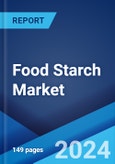Food starch is a complex carbohydrate derived from various plant sources such as corn, wheat, rice, potatoes, and tapioca. The starch is extracted from these sources and then processed to remove impurities and improve its functional properties. Food starch is a versatile ingredient in the food industry that improve the shelf life of foods and prevent them from breaking down during storage. There are numerous types of food starch available, each with its own unique properties and characteristics. For instance, some starches are more resistant to heat and acid, making them ideal for acidic foods or high-temperature processing. Other starches are more easily digestible and can be used in products designed for people with specific dietary needs. In recent years, food starch has gained traction due to the exponential growth in the food and beverage (F&B) industry.
Food Starch Market Trends:
One of the primary factors driving the market is the rising utilization of food starch as a thickener, stabilizer, and binding agent in the food industry. Additionally, the increasing demand for processed and convenience foods is creating a positive market outlook. Other than this, with busy lifestyles and changing dietary habits, consumers are increasingly opting for ready-to-eat meals, snacks, and bakery products, which require the use of food starch, thus positively influencing the market growth. In line with this, significant technological advancements in food processing have also played a significant role in expanding food starch applications, thereby escalating its demand globally. Furthermore, with the growing health concerns, consumers are choosing healthier food options. Due to this, the demand for functional ingredients like food starch is expected to increase, creating new opportunities for manufacturers in the food industry. Apart from these factors, the increasing awareness among consumers about the clean-label and natural food ingredients has encouraged them to look for products that are made with natural and minimally processed ingredients. This has accelerated the product demand as food starch is derived from various natural sources, including corn, wheat, and potatoes, making it an attractive ingredient for consumers who are seeking natural and clean-label products. Apart from this, the increasing popularity of gluten-free products is also driving the demand for food starch as it can be used as a substitute for gluten in many food products, making it a valuable ingredient for manufacturers of gluten-free foods.Key Market Segmentation:
The publisher provides an analysis of the key trends in each segment of the global food starch market, along with forecasts at the global, regional, and country levels from 2025-2033. Our report has categorized the market based on the raw material, product type, and end user.Raw Material Insights:
- Maize
- Wheat
- Potato
- Cassava
- Others
Product Type Insights:
- Native Starch
- Modified Starch
- Starch Derivatives
End User Insights:
- Business to Business
- Confectionary
- Bakery
- Dairy
- Beverages
- Others
- Business to Consumer
Regional Insights:
- North America
- United States
- Canada
- Europe
- Germany
- France
- United Kingdom
- Italy
- Spain
- Russia
- Others
- Asia Pacific
- China
- Japan
- India
- South Korea
- Australia
- Indonesia
- Others
- Latin America
- Brazil
- Mexico
- Others
- Middle East and Africa
Competitive Landscape:
The report has also provided a comprehensive analysis of the competitive landscape in the global food starch market. Detailed profiles of all major companies have also been provided. Some of the companies covered include AGRANA Beteiligungs-AG (AGRANA Zucker, Starke, Starke und Frucht Holding AG), Archer-Daniels-Midland Company, BENEO (Sudzucker Group), Cargill Incorporated, Grain Processing Corporation (Kent Corporation), Ingredion Inc., Roquette Freres, Royal Avebe, Sonish Starch Technology Co. Ltd., SPAC Starch Products (India) Private Limited, Tereos, etc. Kindly note that this only represents a partial list of companies, and the complete list has been provided in the report.Key Questions Answered in This Report:
- How has the global food starch market performed so far, and how will it perform in the coming years?
- What are the drivers, restraints, and opportunities in the global food starch market?
- What is the impact of each driver, restraint, and opportunity on the global food starch market?
- What are the key regional markets?
- Which countries represent the most attractive food starch market?
- What is the breakup of the market based on the raw material?
- Which is the most attractive raw material in the food starch market?
- What is the breakup of the market based on the product type?
- Which is the most attractive product type in the food starch market?
- What is the breakup of the market based on the end user?
- Which is the most attractive end user in the food starch market?
- What is the competitive structure of the global food starch market?
- Who are the key players/companies in the global food starch market?
Table of Contents
Companies Mentioned
- AGRANA Beteiligungs-AG (AGRANA Zucker
- Starke
- Starke und Frucht Holding AG)
- Archer-Daniels-Midland Company
- BENEO (Sudzucker Group)
- Cargill Incorporated
- Grain Processing Corporation (Kent Corporation)
- Ingredion Inc.
- Roquette Freres
- Royal Avebe
- Sonish Starch Technology Co. Ltd.
- SPAC Starch Products (India) Private Limited
- Tereos
Table Information
| Report Attribute | Details |
|---|---|
| No. of Pages | 140 |
| Published | March 2025 |
| Forecast Period | 2024 - 2033 |
| Estimated Market Value ( USD | $ 27.1 Billion |
| Forecasted Market Value ( USD | $ 40.5 Billion |
| Compound Annual Growth Rate | 4.6% |
| Regions Covered | Global |
| No. of Companies Mentioned | 13 |









